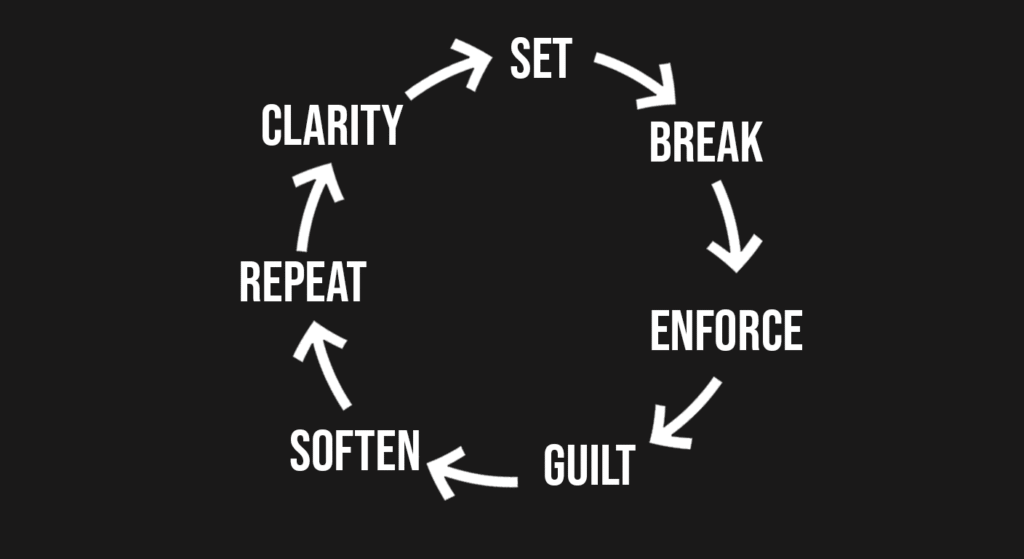From Guilt to Clarity: When “You’re Keeping Us Away” Isn’t the Truth

Guilt is a fog machine. It makes you second-guess your convictions and say yes to things you’d never allow if you were fully clear. Here’s the reframe: you’re not keeping kids from grandparents; repeated boundary-breaking is what creates distance. This article helps you spot common guilt scripts, answer them with factual compassion, and keep the invitation open: “We want time together. Here’s what makes that safe and aligned.” Step out of fog, back into clarity.
Why Guilt Feels So Heavy in Family Boundaries
 Few forces cloud judgment faster than guilt—especially when it comes wrapped in love and history. When a grandparent says, “We never get to see the kids anymore,” or “You’ve changed since you had children,” your heart sinks. You question your motives, your boundaries, and even your worth as a loving child.
Few forces cloud judgment faster than guilt—especially when it comes wrapped in love and history. When a grandparent says, “We never get to see the kids anymore,” or “You’ve changed since you had children,” your heart sinks. You question your motives, your boundaries, and even your worth as a loving child.
But here’s the truth: guilt thrives where clarity is absent. It feeds on half-explained boundaries and misunderstood motives. Most grandparents aren’t trying to manipulate; they’re expressing grief over lost access. Yet the way they express it—through guilt—distorts reality.
Healthy families trade guilt for clarity. Instead of collapsing into apology, you can hold steady with compassion: “We love you. We want you in their lives. Here’s what helps keep it safe and peaceful for everyone.”
If you need language for those delicate talks, pair this article with The Conversation Kit: Scripts for Respectful Boundary Talks with Grandparents. Together, they form your calm-confidence toolkit.
The Emotional Physics of Guilt
 When guilt enters a conversation, it shifts the center of gravity. You move from the logic of values and safety to the emotion of approval and belonging. Suddenly, you’re no longer discussing what’s best for your kids—you’re trying to prove you’re not cruel.
When guilt enters a conversation, it shifts the center of gravity. You move from the logic of values and safety to the emotion of approval and belonging. Suddenly, you’re no longer discussing what’s best for your kids—you’re trying to prove you’re not cruel.
Guilt distorts three things:
- Motives — You start believing you’re selfish for protecting your children.
- Memory — You forget the repeated patterns that forced these boundaries.
- Momentum — You freeze instead of leading, hoping guilt will go away if you give in once more.
But appeasement doesn’t heal; it reinforces the cycle. The next time you say no, the guilt returns stronger. The only antidote is truth spoken with calm confidence.
As the cornerstone Grandparent Boundary Playbook reminds us: “Boundaries aren’t punishment—they’re protection.” Clarity brings peace, even when it stings at first.
Common Guilt Scripts (and the Truth Beneath Them)
 Grandparents who feel excluded rarely mean harm—but their words often land like guilt arrows. Below are common guilt statements and the truth you can calmly anchor to.
Grandparents who feel excluded rarely mean harm—but their words often land like guilt arrows. Below are common guilt statements and the truth you can calmly anchor to.
1. “You’re keeping us away from our grandkids.”
Truth: Choices shape access. Boundaries are not walls—they’re invitations to healthy interaction.
Your Response:
“We want time together. When our agreed boundaries are respected, it’s easy to plan more visits. We’re looking forward to that.”
2. “We raised you fine without all these rules.”
Truth: You’re building on their foundation, not erasing it. Parenting evolves as knowledge grows.
Your Response:
“You gave us a great start. We’re continuing that consistency with the new information we have now. We’re grateful for what you taught us.”
3. “You’re making everything too serious—it’s just sugar/screen time/fun.”
Truth: Repetition creates values. What feels small accumulates into patterns that shape a child’s character.
Your Response:
“We know it seems small, but it helps them learn moderation. We appreciate your support—it really keeps their routine peaceful.”
4. “You think you’re better than us now.”
Truth: Growth isn’t superiority—it’s stewardship. Every generation updates the playbook.
Your Response:
“Not at all. You gave us strength and values we’re building on. This is our way of honoring what you started.”
5. “One day they’ll resent you for keeping them from us.”
Truth: Children remember peace and safety, not unstructured access. Stability builds trust.
Your Response:
“We’re doing our best to give them both—connection and consistency. When everyone follows the same rhythm, they feel secure.”
Why Clarity Is Kinder Than Compromise
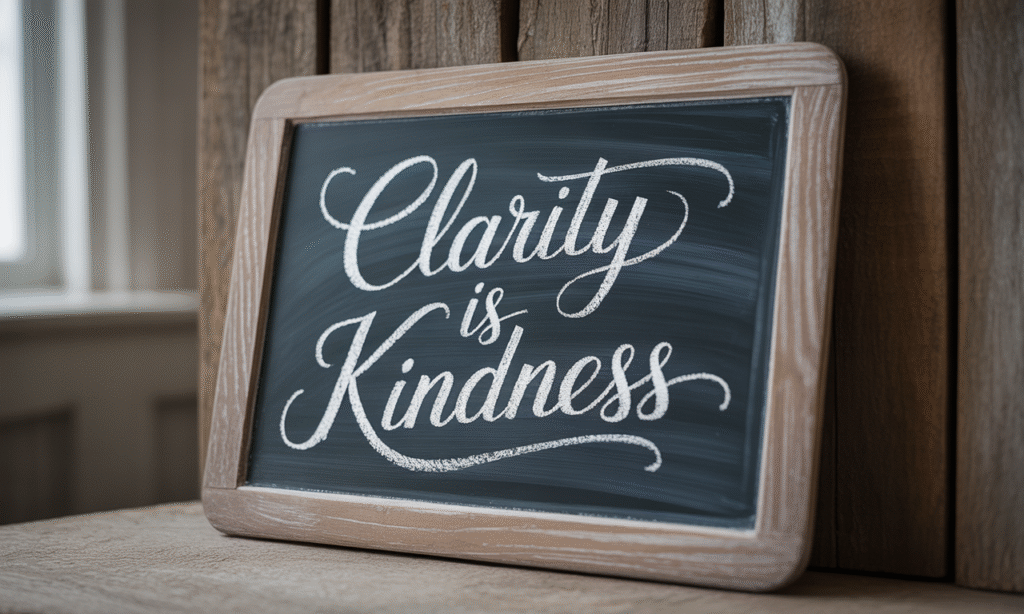 You might think compromise keeps peace—but half-boundaries create double confusion. Kids see mixed signals; grandparents feel the rules shift; you feel drained.
You might think compromise keeps peace—but half-boundaries create double confusion. Kids see mixed signals; grandparents feel the rules shift; you feel drained.
Clarity may sting at first, but it breeds lasting peace. When everyone knows what’s true and consistent, tension has nowhere to hide.
Here’s the paradox: clear parents are often accused of being rigid, but they actually make relationships easier. Grandparents may resist at first, but they’ll eventually feel safer knowing what to expect.
Clarity doesn’t mean confrontation. It means structure that protects everyone’s dignity.
The Cycle of Guilt and How to Break It
- Boundary Set →
- Boundary Broken →
- You Enforce →
- They React with Guilt →
- You Soften →
- They Repeat
This loop continues until clarity replaces guilt as the core motivator.
To break it:
- Write your top three family boundaries.
- Agree with your spouse on exact language to explain them.
- Respond to guilt with calm repetition, not re-explanation.
- Anchor in shared purpose: “We want more connection, not less.”
That’s how guilt loses its grip. Not through arguments—but through peaceful consistency.
Turning Guilt into Gratitude
 It’s easy to feel defensive when guilt hits, but what if you reframed it? Each guilt moment is proof that grandparents still want closeness. Beneath the frustration lies love, even if misdirected.
It’s easy to feel defensive when guilt hits, but what if you reframed it? Each guilt moment is proof that grandparents still want closeness. Beneath the frustration lies love, even if misdirected.
You can redirect guilt energy into gratitude by naming their intention before restating your boundary:
“I know you just want to be part of their lives. That means a lot. Because we’re the parents, we’re choosing to keep things consistent so everyone stays peaceful.”
That small bridge—recognizing love first—diffuses 80% of the conflict. The rest is just follow-through.
Using Calm Truth to Replace Emotional Fog
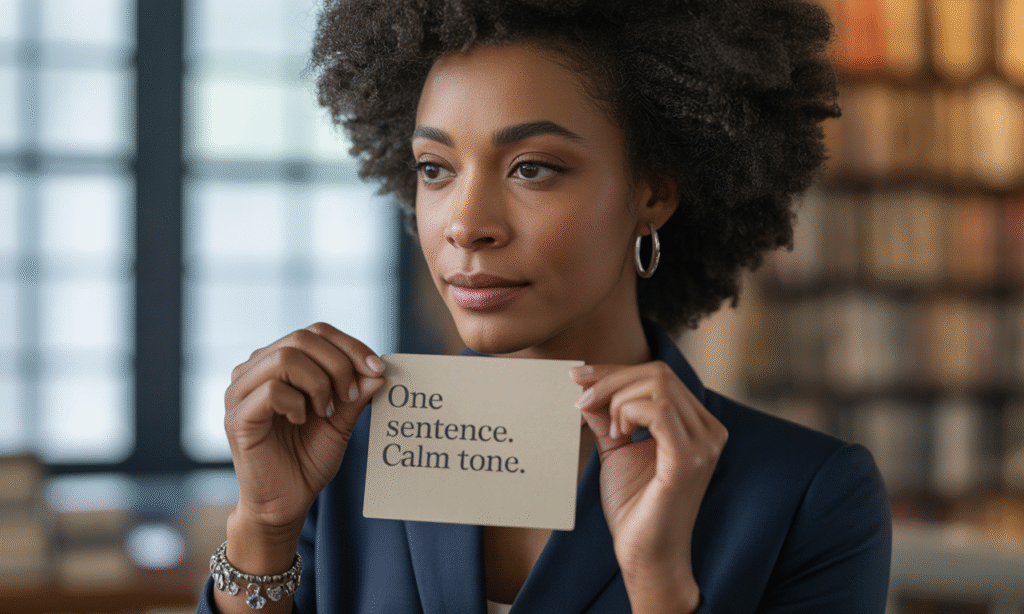 Guilt makes you overtalk. Clarity makes you concise.
Guilt makes you overtalk. Clarity makes you concise.
You don’t need to defend your choices—just define them.
A quick test for clarity:
- Can you explain the boundary in one sentence?
- Can you say it without raising your voice or your heart rate?
- Can you repeat it tomorrow, exactly the same way?
If yes, you’re already out of guilt’s fog.
Rebuilding Relationship After Guilt
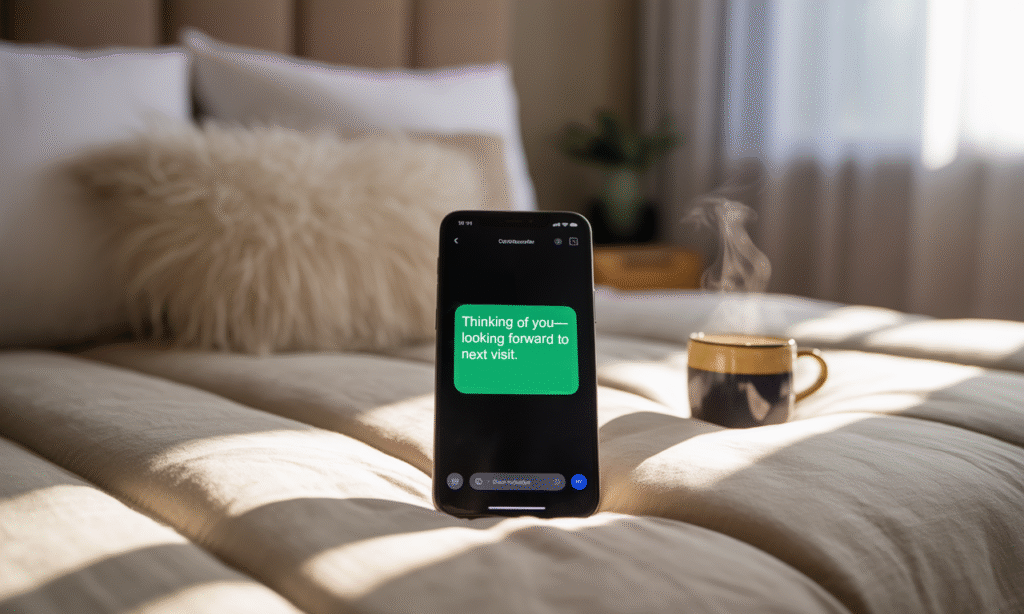 After a guilt-heavy exchange, don’t disappear. That silence can confirm the grandparent’s worst fear—that you’re done with them. Instead, show calm persistence:
After a guilt-heavy exchange, don’t disappear. That silence can confirm the grandparent’s worst fear—that you’re done with them. Instead, show calm persistence:
- Send a photo of the kids with a kind message: “Thinking of you—can’t wait for our next visit.”
- Follow up with clarity: “We’ll plan something soon; once we’re on the same page about the bedtime schedule, it’ll be even better.”
It’s possible to be both firm and warm. Boundaries heal faster when love stays visible.
For guidance on how to move from breach to repair, read When They Won’t Respect the Boundary: Consequences, Repair, and a Path Back. It shows how to design gentle consequences that build trust instead of resentment.
Teaching Kids How to Handle Guilt
 Children absorb guilt dynamics even when they don’t understand the words. When they see you calmly resist emotional pressure, they learn resilience.
Children absorb guilt dynamics even when they don’t understand the words. When they see you calmly resist emotional pressure, they learn resilience.
You can even narrate it gently to model emotional literacy:
“Grandma’s sad she can’t do sleepovers right now. We’re sad too. But we know it’s best for everyone. We’ll see her soon.”
That one sentence teaches your child more about emotional strength than a dozen lectures.
The Spiritual Side of Clarity
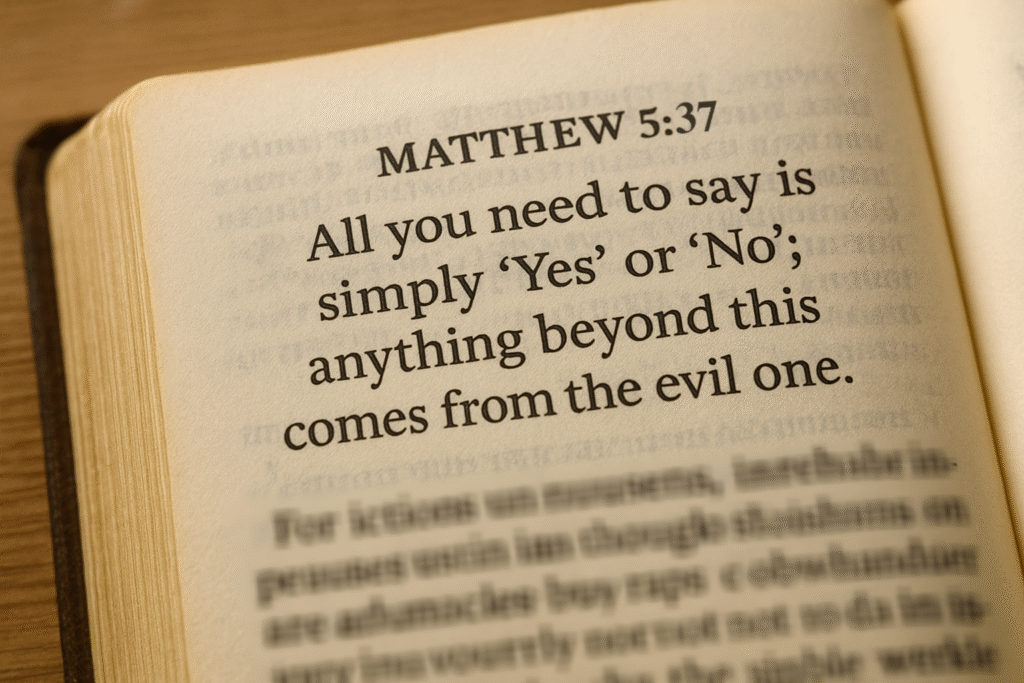 For faith-driven families, guilt often wears religious language: “Honor your parents,” “Family comes first,” or “You’re supposed to forgive.”
For faith-driven families, guilt often wears religious language: “Honor your parents,” “Family comes first,” or “You’re supposed to forgive.”
Honoring doesn’t mean obeying unhealthy patterns—it means responding with respect while leading your home faithfully.
When you resist guilt, you’re not rebelling against your parents; you’re stewarding the next generation with wisdom.
God never uses guilt as a motivator—only conviction rooted in truth and love.
Clarity aligns your household with peace:
“Let your ‘Yes’ be yes and your ‘No’ be no.” (Matthew 5:37)
Rewriting the Family Narrative
 One of guilt’s hidden costs is narrative distortion. It tells a false story: “You’re separating the family.” In truth, you’re strengthening it by building healthier habits.
One of guilt’s hidden costs is narrative distortion. It tells a false story: “You’re separating the family.” In truth, you’re strengthening it by building healthier habits.
When you stay consistent, over time grandparents will start retelling the story too: “At first we didn’t understand, but now we see how much calmer visits are.”
You’re changing generational culture—not through confrontation, but through endurance.
Every peaceful visit built on mutual respect rewrites the family story from guilt to grace.
The Boundary Reframe That Ends Guilt
 When guilt rises, try this short reframe:
When guilt rises, try this short reframe:
“We’re not keeping them away. We’re keeping them safe. You can always be close—just not at the cost of consistency.”
This reframing shifts the narrative from distance to design. You’re not a gatekeeper; you’re a gardener, tending the environment your children grow in.
The Checklist for Staying in Clarity
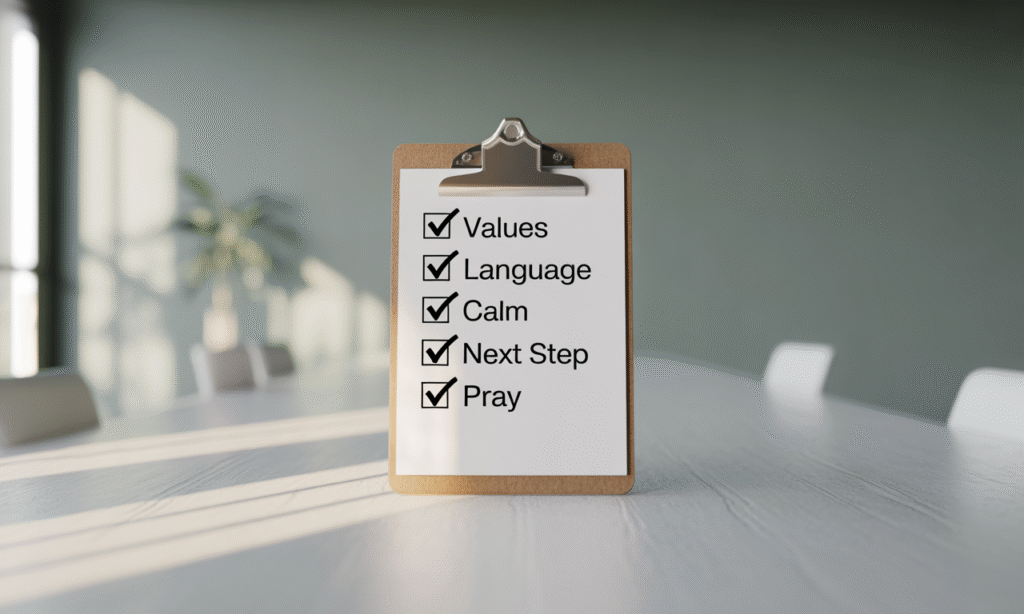 Before any major boundary conversation or visit, check these quick reminders:
Before any major boundary conversation or visit, check these quick reminders:
- I know my why (values over guilt).
- I’ve agreed with my spouse on the language.
- I can say it calmly in one sentence.
- I’ve prepared a next step (visit plan, compromise option).
- I’ve prayed or centered myself before speaking.
Clarity doesn’t come from courage alone—it comes from preparation.
When Guilt Turns into Manipulation
 There’s a line between emotional expression and manipulation. You’ll know it’s crossed when guilt is used repeatedly to override clearly stated boundaries.
There’s a line between emotional expression and manipulation. You’ll know it’s crossed when guilt is used repeatedly to override clearly stated boundaries.
In those moments, reassert calmly:
“We understand this is painful, but our decision stands. We love you, and we’re open to rebuilding when we can both honor these limits.”
If guilt persists, scale back contact temporarily—but keep the door open with kind, factual updates. Protect your peace while modeling respect.
Conclusion: Guilt Is a Detour—Clarity Is the Path
 Guilt may sound like love, but clarity acts like love. It creates safety, stability, and trust.
Guilt may sound like love, but clarity acts like love. It creates safety, stability, and trust.
Every time you replace guilt with calm truth, you model integrity for your kids and maturity for your parents.
You’re not the villain in this story—you’re the steward.
Your job isn’t to keep everyone happy; it’s to keep everyone healthy.
Step out of fog.
Stand in clarity.
And let love—not guilt—lead your family forward.


